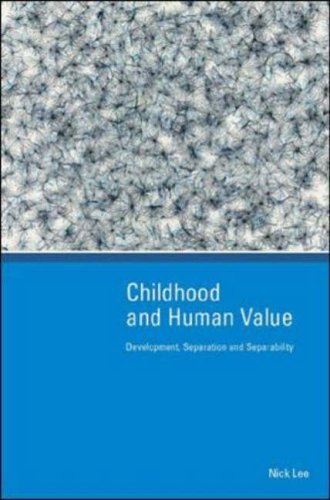Childhood and Human Value
Lee, Nick
Open University Press, Buckingham
2005
0335214231 (pb)
 Nick Lee, is his second major work, has again produced a text of significant value to the increasing body of literature concerning the sociology of childhood. This contemporary focus of sociology is concerned with childhood as a permanent structure of society, and Lee's Childhood and Human Value: Development, Separation and Separability directs attention to children's '…growth and change without needing to posit a hidden plan of development that awaits discovery'.
Nick Lee, is his second major work, has again produced a text of significant value to the increasing body of literature concerning the sociology of childhood. This contemporary focus of sociology is concerned with childhood as a permanent structure of society, and Lee's Childhood and Human Value: Development, Separation and Separability directs attention to children's '…growth and change without needing to posit a hidden plan of development that awaits discovery'.
Consisting of five key sections, the text challenges two specific reactionary impulses occurring when debating the differences between childhood and adulthood, especially in consideration of human rights. Firstly, reference to the 'love' inherent in the relationship between child and adult shows it to exist alongside power and authority as a core feature. This conflict between love and nurture, and power and authority, is explored by Lee and termed 'separability'. The second challenge is obvious within discourse concerning rights of children, which in many cases mask, and reinforce, inequality between childhood and adulthood.
Referring to the work of many, ranging from classical Freud and Piaget, to Bernstein and Beck, feminists Gilligan and Winnicott, and the contemporary work of James and Prout, Lee examines:
• Possession and separation: resistance to children's rights
• Social status and performances of separation
• Separability and integration
• Competence and separability
• Human value and childhood
These five sections are an attempt to demonstrate that a mutually supportive co-existence of love and rights between children and adults is possible. Since the 1989 United Nations Convention on the Rights of the Child (General Assembly of the UN 1989), ideas began to form that children were not possessions, but instead may be self-possessed. However, the challenge for many lay in accepting that whilst children may require support from adults, they were not solely dependents of adults. Making this distinction of separability is the key to unravelling complexities concerning how, and in what way, do we ensure children have rights as a self-possessed human.
It is important to recognise in Lee's work that when arguing for separability, it is not suggesting separateness, as these are two distinct issues. Children, by nature of their status, cannot be separate but instead can possess separability. This distinction acknowledges that separability would alter children's cultural position, thereby allowing for a revisit to existing social policies, changes to government funding allocations for children's welfare programmes, and exploring parental responsibilities to ensure the wellbeing of children.
Lee openly recognises two limitations within this text, however his acknowledgement also ensures that analytical discussions are within this context. Firstly, discourse concerning children's rights are focused upon tensions in the Western, industrialised world. Secondly, it is the ideal world that would adopt and implement Lee's suggestions, however he argues that recognising women's rights was a challenge and continues to be an ongoing process. Similarly, advocates for children's rights may see a slow but continual process to accept the value of children, and afford them a higher consideration within policy, processes, practice, and societal structures.
Whilst some of Lee's theoretical discussions may be challenging for the undergraduate student, his precise arguments within Childhood and Human Value: Development, Separation and Separability suggest it should be highly recommended as a key text for those interested in the sociology of childhood, advocates for children's rights, and for those faced with acknowledging the self-possession of children.
Sharon Brennan
University of Melbourne

